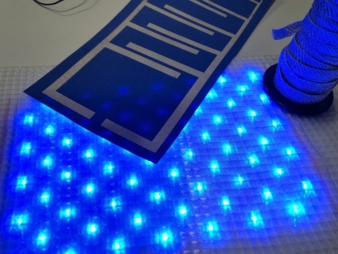14/01/2019 – Smart Textiles — auf Deutsch lesen
Textile electrodes for smart monitoring
Textiles with intelligent extras are entering, not just in medicine. Occupational safety and clothing benefit such as construction, production and logistics.
From ECG T-shirts for telemedicine or feedback systems, high-tech wheelchair gloves to airbags for construction workers and textile touch screens for controlling machinery–smart textiles are the new high flyer among technical fabrics and becoming ever more popular. Providing critical input, the German textiles research has been stimulating this trend over the past decade.
Growth more than 25 percent
After undergoing significant structural change, the German textiles industry has clinched a leading position in the relatively new sector of technical textiles. Although analysts worldwide tend to disagree on the exact figures, there is consensus on one fact: this market segment is set for continuing growth. According to current market predictions up to the year 2020, demand in application areas such as architecture, fashion, automotive, defence, sports and medicine will generate annual market growth of over 25 percent in Europe. New technological capabilities such as textile sensors, generation of thermal energy or tech-textile lighting solutions are expected to have doubled their 2016 market volume by 2021.
Metallised threads
A global supplier on this growth market, Statex Produktions- und Vertriebs GmbH (Bremen, Germany) produces metallised threads, mostly coated in silver. Yarns and fabrics manufactured from these threads are customisable and highly conductive and can be used for measuring vital parameters, for stimulation, lighting, heating and cooling as well as alarm systems. Numerous research projects into smart textiles have already been completed successfully in locations like Aachen, Chemnitz, Denkendorf, Greiz and Mönchengladbach and the first set of telemedical products will likely be launched soon. One goal of these developments is to replace traditional dry electrodes with textile electrodes woven into T-shirts, thus granting patients greater mobility.
Pioneer in smart light wear technology
From lab projects to market–this is the vision of Lunative, a Hamburg-based company and one of the leading players in the development of smart light wearable technology. One of their projects involves the seamless integration of e-mobile components into garments and other products. So far, the company has already manufactured the first product batches to order, among them uniforms for flight attendants and fabrics with lighting capabilities for car interiors. According to developer Andreas Lanyi, the company’s product and development portfolio covers everything from simple standalone solutions for market testing and evaluation or market launches to fully-connected technical ecosystems for trade and industry. Light plays one of the most important roles in this area: both for attracting attention and for enhancing safety and communications. It can furthermore be complemented by smart sensor and actuator systems compatible with textiles.
Sensors for a better quality of life
Sensomative, a start-up located in Rothenburg in Switzerland, recently developed a product which combines textile sensors and intelligent classification algorithms to prevent bedsores. The company is a spin-off founded by the EHT Zurich in 2015 and has developed this product in cooperation with the university. It is now being tested in a smart cushion for wheelchair users: the “Sensomative wheelchair” contains a textile sensor layer for the wheelchair seat and can be connected to an app which analyses sitting behaviour and pressure. From these inputs, it calculates recommendations for active measures which are then forwarded as instructions to the user's smart watch or smartphone. Practical tests have already shown a significant reduction in the risk of impaired circulation and chronic wounds and proven a high degree of approval among users.
Rucksacks, travel bags and belt pouches
Thieves are now increasingly targeting textile containers with the help of knives and similar cutting tools. Bagjack, a Berlin company, worked with textiles researchers from Saxony to find a practical solution to this problem: a protective fleece lining for the inside of a bag or pocket that emits an acoustic alarm and sends messages to the owner’s smartphone when it is pierced. This textile product with its alarm functions is currently predominantly used in the private and courier sectors but the company is working on additional smart transport case features for various applications in logistics. These textile containers will be interconnected via a sensor network. They will communicate directly with the central office to keep it updated on the status of the goods and enable fast reaction times in case of an incident. Another topic on the company’s to do list: products made of modular, connected parts which enable a hassle-free replacement of damaged components. The respective plugs that will be applied to conductive textiles are currently in development.
7th Smart Textiles User Forum
These and other recent technical and product developments from Austria, Germany and Switzerland will be showcased in Bad Waldsee at the 7th Smart Textiles User Forum in late February 2019. “Goal of this interdisciplinary forum is to inspire participants to develop ideas for new products, services and technologies, but it also serves to focus the smart textiles competencies of the GAS region,” explains Prof Dr Götz T. Gresser, organiser of the forum and representative of the German Institutes for Textiles and Fibre Research (DITF), Europe’s largest site for textiles sciences. The most recent developments in the smart textiles sector showcased here will include, among others: sensor gloves for logistics and heated trousers for skiers to keep their muscles warm and agile.
7th Smart Textiles User Forum
27–28 February 2019
Bad Waldsee





